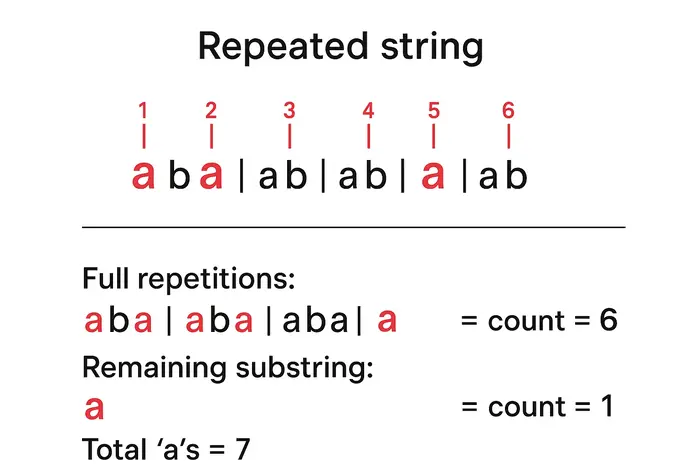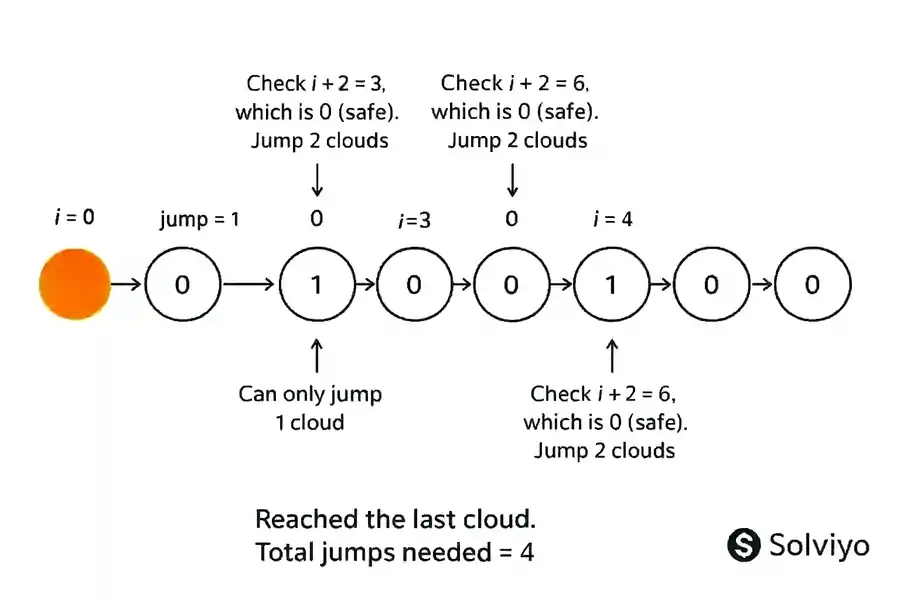Why Solving HackerRank Alternating Characters Problem Is Important?
String problems like HackerRank Alternating Characters are more than just coding puzzles—they strengthen your understanding of string manipulation, consecutive duplicate detection, and pattern optimization. Mastering this challenge builds the foundation for solving real-world data structure and algorithm questions efficiently.
The Alternating Characters problem teaches how to count and remove consecutive duplicates in a string using simple iteration and logic, without relying on extra data structures. This enhances your grasp of time complexity analysis and helps you think algorithmically—key skills for technical interviews and competitive programming.
Solving it in C++ or any programming language improves your ability to write optimized, linear-time algorithms. You learn to focus on clean logic, memory efficiency, and minimal string operations—all essential when solving string-based coding challenges on platforms like HackerRank, LeetCode, and Codeforces.
Practicing this problem also sharpens your ability to analyze patterns and edge cases, such as sequences with repeated characters or empty strings. These insights translate directly into stronger analytical thinking and debugging habits in professional software development.
Whether you’re preparing for FAANG interviews, aiming to improve your competitive programming rank, or just building a strong algorithmic foundation, HackerRank Alternating Characters is a perfect exercise to deepen your understanding of string logic, character comparison, and algorithm optimization.
In short, mastering this problem helps you think like an algorithm designer—efficiently, logically, and precisely. It’s not just about deleting characters; it’s about building a mindset for mathematical reasoning and optimized coding.
HackerRank Alternating Characters Problem Overview
The HackerRank Alternating Characters problem requires you to remove the minimum number of characters from a string so that no two identical characters are adjacent. The goal is to ensure that the resulting string alternates between different characters.
The input consists of a number of queries (q) followed by strings (s). For each string, you need to calculate and return the minimum number of deletions required to make it an alternating sequence of characters.
This problem is a great exercise in string manipulation and iteration logic. It helps you think about how to efficiently process strings and count necessary operations without extra space.
Problem Difficulty & Tags
The Alternating Characters problem on HackerRank is considered an Easy-level problem. It focuses on simple string processing and counting logic.
- Difficulty: Easy
- Tags: Strings, Iteration, Counting, String Manipulation
This problem is ideal for beginners to practice iterating through strings, applying simple conditions, and efficiently counting operations.
Understanding the Problem
The goal of the Alternating Characters problem is to ensure that a string has no two identical characters next to each other. For example, in the string "AABBA", there are consecutive duplicate characters that need to be removed.
For each string, you need to count the minimum number of deletions required to make it alternate properly. You are not required to output the new string—only the count of deletions.
Key points to understand:
- Check each character and compare it with the previous character.
- Every time a character is the same as the previous one, it counts as a deletion.
- The process continues until the end of the string, summing up all necessary deletions.
This understanding helps simplify the problem to a single linear scan of the string.
Approach and Logic Explanation
To solve the Alternating Characters problem efficiently, I used a simple linear scan of the string. Here’s the thought process:
- Initialize a counter (
cnt) to zero. This will track the number of deletions needed. - Iterate through the string from the second character to the end.
- Compare the current character with the previous character.
- If they are the same, increment the counter (
cnt++) because this character needs to be removed. - If they are different, no deletion is needed, move to the next character.
- If they are the same, increment the counter (
- After the loop ends, the counter (
cnt) represents the minimum deletions required to make the string alternate. - Repeat this process for each query string provided.
This approach ensures O(n) time complexity per string and uses O(1) extra space, making it very efficient.
C++ Solution Code for Alternating Characters
Below is my C++ implementation for the Alternating Characters problem. It counts consecutive duplicate characters and returns the minimum number of deletions required.
#include <bits/stdc++.h>
using namespace std;
string ltrim(const string &);
string rtrim(const string &);
int alternatingCharacters(string s) {
int cnt = 0;
for (size_t i = 1; i < s.size(); i++) { // use size_t for index
if (s[i] == s[i-1]) {
cnt++;
}
}
return cnt;
}
int main() {
ofstream fout(getenv("OUTPUT_PATH"));
string q_temp;
getline(cin, q_temp);
int q = stoi(ltrim(rtrim(q_temp)));
for (int q_itr = 0; q_itr < q; q_itr++) {
string s;
getline(cin, s);
int result = alternatingCharacters(s);
fout << result << "\n";
}
fout.close();
return 0;
}
string ltrim(const string &str) {
string s(str);
s.erase(
s.begin(),
find_if(s.begin(), s.end(), [](unsigned char ch) { return !isspace(ch); })
);
return s;
}
string rtrim(const string &str) {
string s(str);
s.erase(
find_if(s.rbegin(), s.rend(), [](unsigned char ch) { return !isspace(ch); }).base(),
s.end()
);
return s;
}
Step-by-Step Walkthrough
Let’s break down how the solution works using an example string:
Example String: "AABAAB"
- Start with a counter
cnt = 0to track deletions. - Compare the second character with the first: "A" vs "A". They are the same, so increment
cnt→cnt = 1. - Compare the third character "B" with the second "A". They are different, so no deletion is needed.
- Compare the fourth character "A" with the third "B". Different, no deletion.
- Compare the fifth character "A" with the fourth "A". Same, increment
cnt→cnt = 2. - Compare the sixth character "B" with the fifth "A". Different, no deletion.
At the end, cnt = 2, which means we need to delete two characters to make the string alternate properly.
This linear scan ensures O(n) time complexity and requires only a single variable for counting, making it very efficient for large strings.
Sample Input & Output
Here’s an example illustrating how the input is processed and the corresponding output:
| Input | Output | Explanation |
|---|---|---|
| 3 AABAAB AAAA ABABAB |
2 3 0 |
1. "AABAAB": deletions needed = 2 (remove 2nd 'A' and 5th 'A') 2. "AAAA": deletions needed = 3 (remove all consecutive duplicates) 3. "ABABAB": no deletions needed, already alternating |
Time and Space Complexity of the C++ Solution
Time Complexity
The solution iterates through each character of the string exactly once. For a string of length n, the time complexity is O(n). Since we process each query independently, if there are q queries, the total time complexity is O(q * n), where n is the length of each individual string.
Space Complexity
The solution uses only a few integer variables (cnt and loop indices) and does not require any extra data structures proportional to the input size. Therefore, the space complexity is O(1).
This makes the solution both time and space efficient, suitable even for large input strings.
Alternative Approaches and Optimizations
Below are several ways to solve the Alternating Characters problem. Each approach includes a short description, its time & space complexity, and when you might prefer it. The greedy single-pass or run-length approach is usually the simplest and fastest in practice.
1. Greedy single-pass (recommended)
Walk the string from left to right and count how many times the current character equals the previous character. Each equality indicates a deletion is required. This is the simplest & most efficient approach.
- Time: O(n)
- Space: O(1)
- Pros: Fast, minimal memory, easy to implement.
- Cons: None for this problem; it's optimal.
// C++ (greedy single-pass)
int alternatingDeletions(const string &s) {
int deletions = 0;
for (int i = 1; i < (int)s.size(); ++i) {
if (s[i] == s[i-1]) ++deletions;
}
return deletions;
}
2. Run-length counting
Group consecutive identical characters into runs. For each run of length k, you need k - 1 deletions. This is conceptually the same as the greedy pass but expressed as run-length encoding.
- Time: O(n)
- Space: O(1)
- Pros: Clear when you want to reason about runs; easy to extend to similar problems.
- Cons: Slightly more code to manage run counters.
# Python (run-length)
def alternating_deletions(s: str) -> int:
if not s:
return 0
deletions = 0
run_len = 1
for i in range(1, len(s)):
if s[i] == s[i-1]:
run_len += 1
else:
deletions += run_len - 1
run_len = 1
deletions += run_len - 1
return deletions
3. Stack-based simulation (educational)
Use a stack and push characters; when the top equals the new character, pop (or count a deletion). This demonstrates the idea of removing adjacent duplicates, but it uses extra memory and is unnecessary for this specific problem.
- Time: O(n)
- Space: O(n) worst-case
- Pros: Useful pattern for problems where previous state needs to be more complex (like removing pairs).
- Cons: Extra memory; slower due to push/pop operations.
// Java (stack-based)
int alternatingDeletionsStack(String s) {
java.util.Deque stack = new java.util.ArrayDeque<>();
int deletions = 0;
for (char c : s.toCharArray()) {
if (!stack.isEmpty() && stack.peek() == c) {
deletions++;
} else {
stack.push(c);
}
}
return deletions;
}
4. Iterative regex replacement (not recommended)
Repeatedly replace occurrences of the same character pairs, e.g. using a regex like (.)\1, until none remain. This is generally slow and may have hidden costs in some languages due to repeated string reallocation.
- Time: Potentially O(n²) depending on implementation and engine
- Space: O(n) (temporary strings)
- Pros: Short code in languages with powerful regex engines.
- Cons: Slower, not scalable for long strings.
When to choose which approach?
- Use greedy single-pass for nearly every practical case — minimal code and optimal performance.
- Use run-length if you want to explicitly reason in terms of runs of identical characters or extend to counting transforms.
- Use stack only if the problem evolves to require removals that change neighbor relationships (e.g., cascading removals).
- Avoid repeated regex replacements for performance-critical code or very large inputs.
Mistakes to Avoid & Tips
Related String Manipulation Problems on HackerRank
If you enjoyed solving Alternating Characters, here are some similar string manipulation problems you might find interesting:
Conclusion
Solving the HackerRank Alternating Characters problem helps strengthen your understanding of string manipulation and linear scanning techniques. By simply iterating through the string and comparing each character with the previous one, we can efficiently count the minimum number of deletions required to make the string alternate.
Key takeaways from this problem:
- Linear scans are often sufficient for problems involving consecutive elements in a string.
- Counting operations instead of modifying the string avoids complications with indexing.
- Consider edge cases such as strings that are already alternating or have all identical characters.
- The solution has O(n) time complexity and O(1) space complexity, making it very efficient.
I encourage you to try more string manipulation problems on HackerRank to improve your problem-solving skills and get comfortable with optimizing both time and space complexity.
 100 views
100 views








